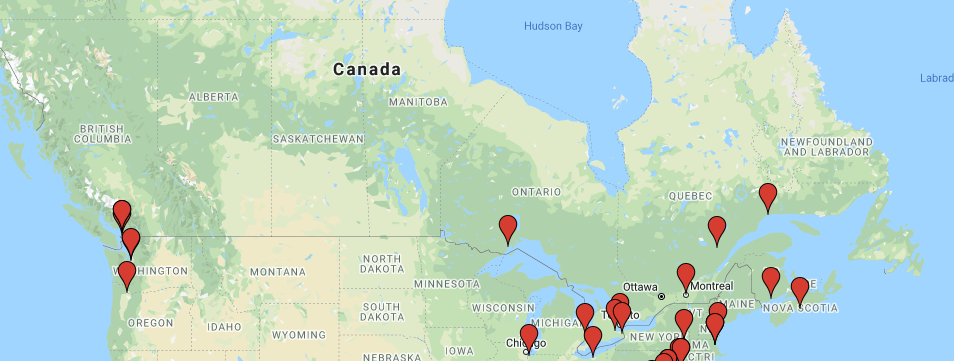By Dr. Jason Zuidema, Executive Director, NAMMA (Montreal, Quebec) with Kevin Walker, Executive Assistant, NAMMA (Halifax, NS)
Introduction
Since the early 19th century, faith-based, not-for-profit organizations have existed in ports in Canada to help visiting seafarers with whatever needs they have. Over the years, those needs have continually changed. At the end of the 19th century, a key need was a cheap, clean boarding house to stay at while waiting to join ship. Later, in the 20th century, the boarding house gave way to mail and phone services and a place to relax for a few hours. Now, in the first decades of the 21st century, a reasonably-priced, high-speed WiFi connection has emerged as the key necessity for seafarers.
The early 21st century has also brought more security restrictions and shorter port turnaround times, however, so that the window of opportunity for most seafarers to buy a data-enabled SIM card or enjoy wifi at a centre is often small or closed. Moreover, public payphone booths have all but disappeared. Some ships provide internet, but a surprising number still have limited or no access: Futurenautics’ 2018 Crew Connectivity Report found that 75% of vessels had some internet access (45% free, 30% at cost), but only 53% had email (49% free, 4% at cost), and only 45% had email with attachments (42% free, 3% at cost). Some ports in Canada provide a public connection, but that too might be low bandwidth or difficult to access.
So, in the past decades, a key activity of seafarers’ ministries around the country has been to go out to ships during their brief time in port, offering data-enabled SIM cards for purchase. Non-profits undertake this work because there is little for-profit business reason to: any profit to be made from the sale of a few SIM cards per day is vastly outweighed by the cost of running vehicles and personnel. The SIM card, a vital connection point between the seafarer and their family, depends on charity for its distribution. As an important note, Canadian mobile wireless rates are some of the highest in the world, so most data-enabled SIM cards are costly for seafarers compared to what they can purchase in countries with more competition. One common SIM card sold frequently by missions in Canada offers 1GB of data for $10 US.
Spring 2020 Survey
Port-based seafarers’ welfare providers are not present at all port facilities in Canada. Most Canadian port authorities do have some form of port-based welfare provider on or near their premises, but these vary greatly in size and scope. Most, though not all, are members of NAMMA. Where seafarers depend on the internet for access to their homes and families, and welfare services are the main internet providers, then, that variation from port to port is consequential.

In order to begin to understand internet provision in Canadian ports, NAMMA developed a short survey that was completed by twelve individuals (eleven port-based seafarers’ welfare providers and one ITF inspector) in different ports from April 30 to May 5, 2020. That number does not allow us to gain accurate data about WiFi in all ports, as each of these ports might have a significant variety of marine terminals. Though the survey is not exact, it provides a general picture of trends in WiFi access in other terminals across Canada. Respondents were predominately in Ports that are members of the Association of Canadian Port Authorities.
Is free WiFi provided at any of the terminals in your port?
6/12 said their ports provided some internet connection, at least at some terminals or some public places; 6/12 said that public internet was not provided anywhere in the Port for seafarers, apart from a seafarers’ centre, if on port property.
If terminals in your port have free WiFi, what is the connection like?
4/6 in ports with public internet noted that the signal was not always reliable or available only at certain terminals in the port.
Therefore, it would seem that at less than 1/3 of ports in our survey, free WiFi was reliably and readily available to all seafarers at a majority of the terminals in the Port.
Do seafarers typically use WiFi from any other provider?
11/12 noted that free, high-speed WiFi was available at the seafarers’ mission building. Internet access was also purchased through data-enabled SIM cards, sold primarily by the missions but also secondarily by ship chandlers or local markets.
6/12 noted that Tim Horton’s, McDonalds or other stores with open WiFi signals close to certain terminals in their ports were also regularly used by seafarers for free WiFi.
Conclusion
The survey was too brief to gather data on the exact WiFi provision of all marine terminals in Canada. However, there was enough data to paint the overall picture of the importance of the internet to seafarers, the challenges of accessing high-speed internet, and the mixed nature of internet provision in Canadian ports.
Finding free, quality WiFi is clearly a priority for seafarers in every port. While seafarers’ missions are doing their part in centres and selling SIMs, and many ports have begun to provide WiFi to visiting seafarers, much is still to be done. We must also be particularly aware of those ports in which there is no mission – what are the odds that there is WiFi there? Hopefully, more advocacy, research, and cooperation with port authorities will help address these challenges, so that with conscientious and informed planning the provision of WiFi to seafarers in Canada may become as universal as their need for it.
About NAMMA: With members in more than 50 ports around North America, NAMMA’s mission is to support those in maritime ministry with professional development, fellowship, and advocacy. http://namma.org/





